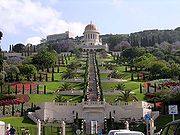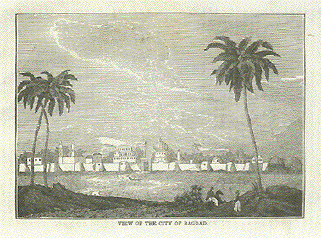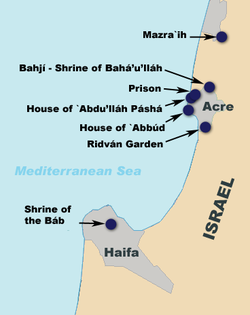
Bahá'í pilgrimage
Encyclopedia

Haifa
Haifa is the largest city in northern Israel, and the third-largest city in the country, with a population of over 268,000. Another 300,000 people live in towns directly adjacent to the city including the cities of the Krayot, as well as, Tirat Carmel, Daliyat al-Karmel and Nesher...
, Akká
Acre, Israel
Acre , is a city in the Western Galilee region of northern Israel at the northern extremity of Haifa Bay. Acre is one of the oldest continuously inhabited sites in the country....
, and Bahjí
Mansion of Bahjí
The Mansion of Bahjí is a term used to describe a summer house in Acre, Israel, where Bahá'u'lláh, founder of the Bahá'í Faith died in 1892. His shrine is located next to this house...
at the Bahá'í World Centre
Bahá'í World Centre
The Bahá'í World Centre is the name given to the spiritual and administrative centre of the Bahá'í Faith. The World Centre consists of the Shrine of Bahá'u'lláh near Acre, Israel, the Shrine of the Báb and its gardens on Mount Carmel in Haifa, Israel, and various other buildings in the area...
in Northwest Israel
Israel
The State of Israel is a parliamentary republic located in the Middle East, along the eastern shore of the Mediterranean Sea...
. Bahá'ís
Bahá'í Faith
The Bahá'í Faith is a monotheistic religion founded by Bahá'u'lláh in 19th-century Persia, emphasizing the spiritual unity of all humankind. There are an estimated five to six million Bahá'ís around the world in more than 200 countries and territories....
do not have access to other places designated as sites for pilgrimage
Pilgrimage
A pilgrimage is a journey or search of great moral or spiritual significance. Typically, it is a journey to a shrine or other location of importance to a person's beliefs and faith...
.
Bahá'u'lláh
Bahá'u'lláh
Bahá'u'lláh , born ' , was the founder of the Bahá'í Faith. He claimed to be the prophetic fulfilment of Bábism, a 19th-century outgrowth of Shí‘ism, but in a broader sense claimed to be a messenger from God referring to the fulfilment of the eschatological expectations of Islam, Christianity, and...
decreed pilgrimage in the Kitáb-i-Aqdas
Kitáb-i-Aqdas
The Kitáb-i-Aqdas is a central book of the Bahá'í Faith written by Bahá'u'lláh, the founder of the religion. The work was written in Arabic under the Arabic title , but it is commonly referred to by its Persian title, Kitáb-i-Aqdas , which was given to the work by Bahá'u'lláh himself...
to two places: the House of Bahá'u'lláh in Baghdad, and the House of the Báb in Shiraz. In two separate tablet
Tablet (religious)
A tablet, in the religious context, is a term traditionally used for religious texts.Jews and Christians believe that Moses brought the Ten Commandments from Mount Sinai in the form of two stone tablets. According to the Book of Exodus, God delivered the tablets twice, the first set having been...
s, known as Suriy-i-Hajj, he prescribed specific rites for each of these pilgrimages. It is obligatory to make the pilgrimage, "if one can afford it and is able to do so, and if no obstacle stands in one's way". Bahá'ís are free to choose between the two houses, as either has been deemed sufficient. Later, `Abdu'l-Bahá
`Abdu'l-Bahá
‘Abdu’l-Bahá , born ‘Abbás Effendí, was the eldest son of Bahá'u'lláh, the founder of the Bahá'í Faith. In 1892, `Abdu'l-Bahá was appointed in his father's will to be his successor and head of the Bahá'í Faith. `Abdu'l-Bahá was born in Tehran to an aristocratic family of the realm...
designated the Shrine of Bahá'u'lláh
Shrine of Bahá'u'lláh
The Shrine of Bahá'u'lláh, located in Bahjí near Acre, Israel, is the most holy place for Bahá'ís and represents their Qiblih, or direction of prayer...
at Bahjí (the Qiblih
Qiblih
In the Bahá'í Faith the Qiblih is the location that Bahá'ís should face when saying their daily obligatory prayers, and is fixed at the Shrine of Bahá'u'lláh, near `Akká, in present day Israel; approximately at ....
) as a site of pilgrimage. No rites have been prescribed for this.
The designated sites for pilgrimage are not accessible to the majority of Bahá'ís, as they are in Iraq
Iraq
Iraq ; officially the Republic of Iraq is a country in Western Asia spanning most of the northwestern end of the Zagros mountain range, the eastern part of the Syrian Desert and the northern part of the Arabian Desert....
and Iran
Iran
Iran , officially the Islamic Republic of Iran , is a country in Southern and Western Asia. The name "Iran" has been in use natively since the Sassanian era and came into use internationally in 1935, before which the country was known to the Western world as Persia...
respectively, and thus when Bahá'ís currently refer to pilgrimage, it refers to a nine-day pilgrimage that occurs at the Bahá'í World Centre in Haifa
Haifa
Haifa is the largest city in northern Israel, and the third-largest city in the country, with a population of over 268,000. Another 300,000 people live in towns directly adjacent to the city including the cities of the Krayot, as well as, Tirat Carmel, Daliyat al-Karmel and Nesher...
and Akká
Acre, Israel
Acre , is a city in the Western Galilee region of northern Israel at the northern extremity of Haifa Bay. Acre is one of the oldest continuously inhabited sites in the country....
in Israel. This nine-day pilgrimage does not replace pilgrimage to the designated sites for pilgrimage, and it is intended that pilgrimage to the House of the Báb and the House of Bahá'u'lláh will occur in the future.
House of Bahá'u'lláh, Baghdad

Bahá'u'lláh
Bahá'u'lláh , born ' , was the founder of the Bahá'í Faith. He claimed to be the prophetic fulfilment of Bábism, a 19th-century outgrowth of Shí‘ism, but in a broader sense claimed to be a messenger from God referring to the fulfilment of the eschatological expectations of Islam, Christianity, and...
lived in from 1853 to 1863 (except for two years where he left to the mountains of Kurdistan, northeast of Baghdad, near the city of Sulaymaniyah
Sulaymaniyah
Sulaymaniyah is a city in Iraqi Kurdistan, Iraq. It is the capital of Sulaymaniyah Governorate. Sulaymaniyah is surrounded by the Azmar Range, Goizja Range and the Qaiwan Range in the north east, Baranan Mountain in the south and the Tasluje Hills in the west. The city has a semi-arid climate with...
). It is located in the Kadhimiya district of Baghdad
Baghdad
Baghdad is the capital of Iraq, as well as the coterminous Baghdad Governorate. The population of Baghdad in 2011 is approximately 7,216,040...
, near the western bank of the Tigris
Tigris
The Tigris River is the eastern member of the two great rivers that define Mesopotamia, the other being the Euphrates. The river flows south from the mountains of southeastern Turkey through Iraq.-Geography:...
river. It is designated in the Kitáb-i-Aqdas
Kitáb-i-Aqdas
The Kitáb-i-Aqdas is a central book of the Bahá'í Faith written by Bahá'u'lláh, the founder of the religion. The work was written in Arabic under the Arabic title , but it is commonly referred to by its Persian title, Kitáb-i-Aqdas , which was given to the work by Bahá'u'lláh himself...
as a place of pilgrimage and is considered a holy place by Bahá'ís.
In 1922 the house was confiscated by Shí'ih authorities, who were hostile to the Bahá'í Faith. The Council of the League of Nations
League of Nations
The League of Nations was an intergovernmental organization founded as a result of the Paris Peace Conference that ended the First World War. It was the first permanent international organization whose principal mission was to maintain world peace...
upheld the Bahá'í's claim to the house, but it has not yet been returned to the Bahá'í community.
House of the Báb, Shiraz


Shiraz, Iran
Shiraz is the sixth most populous city in Iran and is the capital of Fars Province, the city's 2009 population was 1,455,073. Shiraz is located in the southwest of Iran on the Roodkhaneye Khoshk seasonal river...
, Iran
Iran
Iran , officially the Islamic Republic of Iran , is a country in Southern and Western Asia. The name "Iran" has been in use natively since the Sassanian era and came into use internationally in 1935, before which the country was known to the Western world as Persia...
, the Báb
Báb
Siyyid `Alí Muḥammad Shírází was the founder of Bábism, and one of three central figures of the Bahá'í Faith. He was a merchant from Shíráz, Persia, who at the age of twenty-four claimed to be the promised Qá'im . After his declaration he took the title of Báb meaning "Gate"...
declared his mission to Mullá Husayn
Mullá Husayn
Mullá Husayn-i Bushru'i , titled Jináb-i-Bábu'l-Báb , was a Persian religious figure, and the first Letter of the Living of the Bábí movement. He died at the Battle of Fort Shaykh Tabarsi, on February 2, 1849...
on 23 May 1844.
In 1942-3 it was damaged by fire in an attack by enemies of the Bahá'í Faith
Bahá'í Faith
The Bahá'í Faith is a monotheistic religion founded by Bahá'u'lláh in 19th-century Persia, emphasizing the spiritual unity of all humankind. There are an estimated five to six million Bahá'ís around the world in more than 200 countries and territories....
, and in 1955 it was destroyed, but later again restored. In 1979 it was destroyed once more during the Iranian Revolution
Iranian Revolution
The Iranian Revolution refers to events involving the overthrow of Iran's monarchy under Shah Mohammad Reza Pahlavi and its replacement with an Islamic republic under Ayatollah Ruhollah Khomeini, the leader of the...
. In 1981 the site was made into a road and public square.
Current nine-day pilgrimage

Bahá'í World Centre buildings
The Bahá'í World Centre buildings are buildings that are part of the Bahá'í World Centre in Israel. The Bahá'í World Centre buildings include both the Bahá'í holy places used for pilgrimage and the international administrative bodies of the Bahá'í Faith; they comprise more than 20 different...
for more information about each building.
Bahjí:
- Shrine of Bahá'u'lláhShrine of Bahá'u'lláhThe Shrine of Bahá'u'lláh, located in Bahjí near Acre, Israel, is the most holy place for Bahá'ís and represents their Qiblih, or direction of prayer...
- Mansion of BahjíMansion of BahjíThe Mansion of Bahjí is a term used to describe a summer house in Acre, Israel, where Bahá'u'lláh, founder of the Bahá'í Faith died in 1892. His shrine is located next to this house...
Haifa:
- Shrine of the BábShrine of the BábThe Shrine of the Báb is a structure in Haifa, Israel where the remains of the Báb, founder of Bábism and forerunner of Bahá'u'lláh in the Bahá'í Faith, have been laid to rest; it is considered to be the second holiest place on Earth for Bahá'ís, after the Shrine of Bahá'u'lláh in Acre...
- Bahá'í Terraces
- ArcThe Arc (Bahá'í)The Arc is a number of Bahá'í administrative buildings at the Bahá'í World Centre on Mount Carmel located at Haifa, Israel. They include the Seat of the Universal House of Justice, the Seat of the International Teaching Centre, the International Archives, and the Centre for the Study of the Sacred...
- Seat of the Universal House of Justice
- Seat of the International Teaching Centre
- Centre for the Study of the Sacred Texts
- International Archives
- Monument Gardens
- Site of the future House of Worship
- House of `Abdu'l-Bahá
- Resting place of Amatu'l-Bahá Rúhíyyih Khanum
- Pilgrim HousePilgrim HouseThe term Pilgrim House is a term used by Bahá'ís to signify buildings where pilgrims are greeted and housed during pilgrimage to the Bahá'í holy places....
s:- Eastern Pilgrim House
- 10 Haparsim Street
- 4 Haparsim Street
Akká:
- Garden of Ridván, Akká
- House of `Abbúd
- House of `Abdu'lláh Páshá
- Mazra'ih
The nine-day pilgrimage is open only to Bahá'ís and their spouses who have applied to go on pilgrimage.

